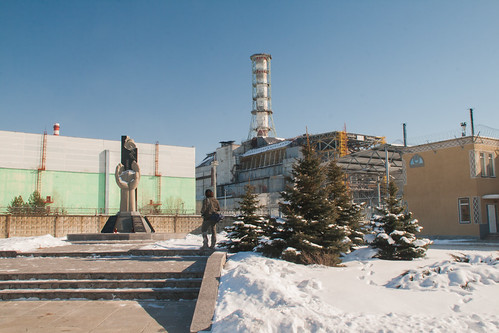Around 8,000 km and 25 years separate the catastrophic Chernobyl and Fukushima nuclear disasters. There are clear differences between the Ukraine and
Around 8,000 km and 25 years separate the catastrophic Chernobyl and Fukushima nuclear disasters. There are clear differences between the Ukraine and Japan-based catastrophes, but what are some of the more subtle distinctions? And how were they similar?
Both power stations opened in the 1970s; Fukushima in 1971 and Chernobyl six years later. The Japanese plant was, then, operating for 40 years before the disaster and the Ukrainian just nine. At the time of each disaster, six reactors were running at Fukushima and four at Chernobyl.
Different causes?
At a first glance, the incidents appear to have different causes. The Chernobyl reactor explosion on April 26, 1986, was the result of an experiment carried out by plant personnel. The Fukushima meltdown, meanwhile, was triggered by an earthquake and subsequent tsunami on March 11, 2011.
However, construction mistakes and negligence have since been cited as being behind both catastrophes.
So, what actually happened?
At Fukushima, the potential dangers of a large tsunami had already been raised, but ultimately ignored. The March 2011 ‘quake destroyed power lines and back-up generators, meaning the plant’s reactors could not be cooled. This caused severe damage, including meltdowns and an explosion.
Operators at Chernobyl made mistakes during the experiment they were carrying out and these errors were initially considered to be the main cause of the catastrophe But the International Atomic Energy Agency (IAEA) later amended its conclusion.
The construction of the RBMK reactor (High Power Channel-type Reactor) used at the station is deemed one of the main reasons behind the accident. The reactor’s developers thought that a certain, disastrous combination of events could not possibly happen at the same time, so the protective systems to prevent such a situation were not created. But this chain of events did occur on the night of April 26; namely the deliberate disabling of the emergency protection equipment and breaking of operating rules. This resulted in a steam explosion inside of the reactor, a raging graphite fire and core meltdown.
Contamination
Both Chernobyl and Fukushima were ranked level seven events on the IAEA’s international nuclear radiological scale – its highest rating. It was concluded that both accidents caused a major release of radioactive material, which adversely affected people’s health and the environment.
But this does not necessarily mean that the Japanese catastrophe was as dangerous for humanity and the environment as Chernobyl, which remains the worst nuclear disaster of our era.
Due to its location, the explosion at Chernobyl caused significant contamination in countries neighbouring Ukraine, such as Belarus and Russia (all were Soviet republics at that time). It reached the whole of Europe in some form, except Portugal.
Radiation from Fukushima continues to seep into the ocean via ground waters – radionuclides have been found in seawater throughout the Pacific – but the contamination consequences for other countries are relatively insignificant. The new system to contain the leaking water was recently approved.
Partially cleaned water from the reactors will also be released into the ocean deliberately later in 2016.
Government reactions
On April 28, 1986, radiation was registered at a nuclear power station in Sweden. Its personnel soon realised that the radiation leak was not local. It would be the first hint that a serious disaster had happened in the Soviet Union. Soviet news programme “Vremya” (“Time”) made a 20-second announcement at the time.
“There has been an accident at the Chernobyl Nuclear Power Plant. One of the nuclear reactors was damaged. The effects of the accident are being remedied. Assistance has been provided for any affected people. An investigative commission has been set up.”
Life continued as normal in Pripyat, the town built for the plant’s workers until evacuation on the 27-th of April.
On May 1, the annual mass parade was held in Kyiv, just 130 km south of the nuclear plant, which was still burning out of control. Ukrainians turned to the international media in an effort to find out what was happening just next door.
Japan didn’t seem to have learnt all the lessons of the Chernobyl accident. Despite a fast evacuation when disaster struck, it took the Japanese government 2.5 months to admit that a meltdown did in fact take place in one of the Fukushima reactors.
On the ground, now
Exclusion zones are in place around both disaster sites: 30 km for Chernobyl and 20 km for Fukushima, with an optional extra 10 km.
Almost the same amount of people were relocated: official sources state 300,000 were displaced in Japan and 350,000 in Ukraine, Belarus and Russia in 1986 and the years following.
Evacuees
Five years on from the catastrophe, many of the Fukushima evacuees still live in temporary housing. They have the right to visit their homes in the exclusion zone for five hours at a time.
Loneliness, split families, health risks. Japanese towns still struggle 5yrs post-#Fukushima https://t.co/vBniS9yG05 pic.twitter.com/kDeADsauSR
— Greenpeace (@Greenpeace) April 10, 2016
Some 1,200 Ukrainians have returned to their homes in the exclusion zones in the 30 years since the explosion, despite this being illegal. Most returnees are elderly people, who work on the land there. In 2013, there were around 200 so-called self-settlers living in the zone.












